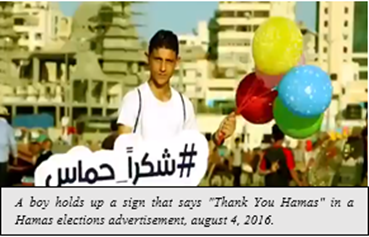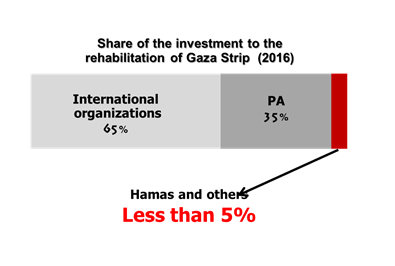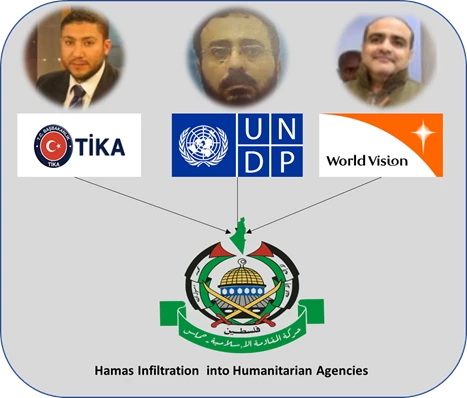Hamas' Exploitation of Humanitarian Aid
Humanitarian Situation in the Gaza Strip: Background
Since Hamas' takeover, the humanitarian situation in the Gaza Strip has sharply deteriorated. High population growth rates have strained Gaza's already struggling economy, slowing down the reconstruction process and placing an unsustainable burden on infrastructure. In 2017, unemployment in the Gaza Strip reached 46%. According to an EU-Mediterranean Human Rights Monitor report, 65% of Gazans live in poverty and 80% are dependent on international aid.
In addition, lack of necessary resources continues to have a detrimental effect on the population. Although a large amount of building materials enters Gaza from Israel (more than 3.5 million tons of construction material in 2016 alone), a significant portion does not reach construction companies, and is instead diverted to Hamas' tunnel building activities. With many building projects frozen as a result, housing prices have risen significantly and unemployment has swelled. A difficult electricity situation in Gaza began in early 2017 when Gaza's only power plant was shut down due to lack of fuel. When the Palestinian Authority ceased payments for Gaza's electricity supply in June 2017, supply was cut by about 40%, leaving Gaza residents with only four to six hours of electricity a day. As a result of the electricity shortage, sewage treatment plants have stopped working as well, causing an increase in the level of water pollution. After suffering from this shortage for over half a year, payments once again resumed in January 2018 in the wake of the Palestinian reconciliation agreements and supply was restored to previous levels of 6-8 hours of electricity a day. Despite this slight relief, the situation is still a tremendous strain on the residents and economy of Gaza.
The factors contributing to the deteriorating situation in Gaza are many. Due to Hamas' practiec of using civilian infrastructure and buildings for military purposes, three military conflicts with Israel have left extensive damage to the Gaza Strip. Relatedly, Gaza's isolation has worsened as a result of shooting attacks towards the crossings, former ties to Islamic State terrorists in the Sinai Peninsula that caused severe limitations on use of the Rafah crossing, and the discovery of a Hamas terror tunnel under the Kerem Shalom crossing that led to the crossing's temporary closure.
Hamas has sought to present itself as a force for improvement and blame Israel for the hardship. A Hamas advertisement video featured Palestinians holding up signs that read "Thank you Hamas" in front of beaches and new buildings. However, this video highlights a very small portion of the Gaza Strip and does not reflect the reality of the vast majority of residents.

Each day, around 700 trucks of supplies, including medication, food, and building material enter Gaza through the Kerem Shalom crossing. During 2016, around 1.3 million tons of goods (food, medication, etc.) and around 3.5 million tons of building materials entered Gaza through this crossing point. A portion of this aid is actually funded by humanitarian organizations and states around the world in the hopes of improving the humanitarian situation in the Strip. In reality, Hamas' repeated exploitation of humanitarian organizations means that many Palestinians in Gaza never see much of the aid they are meant to receive.
Exploitation of Humanitarian Aid
Rather than using its power to improve the humanitarian situation in Gaza, Hamas exacerbates the crisis by refusing to take moral responsibility for the basic needs of its 1.8 million residents and often deliberately exploiting them. Hamas allocates 55% of its budget to fund its military needs and its share in the rehabilitation of Gaza is less than 5% of the total investment. In addition to its disproportionately large military budget, Hamas also diverts aid money to fund its military ventures.

Delivery of supplies is overseen and regulated by Hamas, which collects tariffs from local importers and levies an additional sales tax to the one imposed by the Palestinian Authority. In 2016, Hamas implemented a 20% increase on hundreds of imported goods. According to Israeli figures, Hamas collects $14 for each electrical appliance, $27 for each ton of fruit, and $1.5 for every pack of cigarettes. As a result, merchants are forced to raise the prices of their products, including the most basic necessities such as food and medicine. In addition to the taxes on essential goods, Hamas began imposing a "solidarity tax" in 2015. This tax was touted as a mechanism to support the poor in Gaza but the money has actually been used mainly to pay the salaries of Hamas workers and militants. Hamas' profits from these taxes have increased exponentially, with the average monthly sum rising from about $2.5 million in 2015 to $15 million in 2016 to $27 million in 2017. These taxes are levied on the aid coming into Gaza as well as on the supplies that merchants purchase for trade within Gaza. The money collected in taxes is often used to fund political and military activities.
Hamas occasionally denies civilians access to basic resources such as food and medical care altogether. In 2009, the UN was forced to stop aid shipments to Gaza after it was discovered that Hamas had been seizing hundreds of tons of food and other aid. In one such incident, Hamas stole 200 tons of rice and 100 tons of flour, while in another, 3,500 blankets and over 400 food packages were taken at gunpoint from a distribution center. Again in 2012, Hamas blocked the import of fruits and vegetables from Israel. Since the end of the 2014 Gaza conflict, over 3.4 million tons of construction materials have entered the Gaza Strip from Israel. However, Hamas uses at least some of them to expand its network of tunnels throughout Gaza and into Israel. Most recently in March 2017, in the wake of the assassination of senior Hamas official Mazan Fukha, Hamas closed off the Erez Crossing, the only crossing for people. As a result of this measure, at least 79 Palestinians missed doctors' appointments inside Israel and aid workers were unable to leave or enter Gaza. Although the crossing partially opened a day later, it was still closed to men between the ages of 18 and 45.
In the midst of the electricity situation in Gaza, Hamas continued to exploit the Gazan people's lifelines. Of seven million liters of fuel purchased, only 65% made it to the power station, while the other 35% was sold by Hamas. Furthermore, instead of selling the energy at its true value of $0.85, Hamas sells it at $1.23, pocketing at least $3.05 million in profits.
Infiltration of Humanitarian Agencies
Exploitation of aid occurs behind the scenes as well, where Hamas has on numerous occasions embedded individuals in humanitarian agencies to serve the organization's interests. Three such instances have been documented in the past year.

In June 2016, Hamas operative Muhammed Halabi, who was working in the Christian aid organization World Vision, was accused of diverting funds to Hamas. The case against him states that Hamas recruited Halabi in 2004. He succeeded in transferring $7.2 million annually, amounting to approximately $36 million total to Hamas' military wing and accounting for about 60% of World Vision's Gaza resources. The money, which had been marked for aid programs for disabled children, humanitarian assistance, and food, was instead used to purchase arms, pay fighters' salaries and expand Hamas' tunnel network.
Around one month later in July 2016, it was revealed that a Hamas operative had infiltrated the UN Development Agency (UNDP), the agency responsible for rebuilding the homes of residents whose houses had been destroyed. In reality, the operative ensured that Hamas commanders received priority for such rebuilding projects. He also used the organization's funds to aid in the building of a small seaport for Hamas' military wing and to install weapons stores in buildings throughout Gaza.
In March 2017, Muhammed Faruq Sha'ban Murtaja, who was serving as the Gaza branch manager of the Turkish humanitarian agency Turkish Cooperation and Coordination Agency (TIKA), was arrested on charges of diverting money to Hamas. In his confession, he admitted to exploiting his high-ranking position in the organization in a number of incidents. Under Murtaja's instruction, $13 million donated for the construction of 20 new apartment buildings was used exclusively to build housing for Hamas operatives. He was also responsible for designating a fabricated list of poor Palestinians and students as aid recipients as a cover for three million dollars that he transferred to Hamas operatives. In another incident, he collected four million dollars for a mass wedding for poor couples in Gaza, when in reality the event was for Hamas members only. In total, Murtaja managed to divert nearly $23 million in aid money to Hamas members and families of terrorists.
In addition to preventing humanitarian aid from reaching Palestinians in need, Hamas has shown its priorities through its use of its own budget. Approximately two thirds of the money Hamas raises from international sources is spent on military buildup. Of its total budget, 55% goes to the military wing, a significant increase from 15% in 2014. Meanwhile, Hamas' civil affairs budget has decreased by nearly 50% in that same period. Hamas' financial reports further reveal that tens of millions of dollars designated for rebuilding Gaza were actually being invested in real estate projects in Saudi Arabia, Syria, and Dubai.

